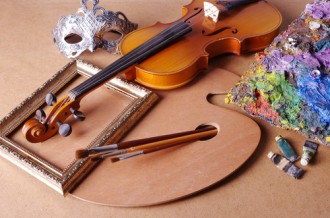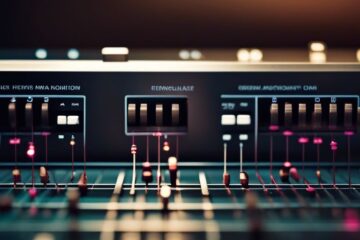Art and music, two of humanity’s most profound forms of expression, have long shared a deep and intertwined relationship. From the ancient frescoes and sculptures that adorned the great halls of classical music venues to the vibrant, multimedia experiences of contemporary art installations, the interplay between these two creative disciplines has been a source of inspiration and innovation. In this blog, we’ll explore how art and music influence each other, shaping cultural landscapes and offering new ways to experience and understand the world around us.
Historical Perspectives: A Harmonious Union
The relationship between art and music is not a recent phenomenon. Throughout history, these two forms of expression have often coexisted, influencing and enhancing each other. In the Renaissance era, for instance, composers like Josquin des Prez and Leonardo da Vinci were contemporaries who lived in a world where visual art and music were deeply interconnected. The aesthetic principles of the Renaissance were reflected in the structured harmonies of the music of the time, while the compositions themselves were often inspired by the visual art of the period.
The Baroque period further exemplified this synergy. The elaborate designs of Baroque architecture and art mirrored the complexity and ornamentation of the music composed during that era. The interplay between the two was evident in opera houses where the visual splendor of the stage design complemented the musical performance, creating a comprehensive sensory experience.
The 20th Century: Breaking Boundaries
The 20th century marked a period of experimentation and boundary-breaking in both art and music. The rise of modernism and abstract expressionism in art paralleled the emergence of new musical forms like jazz and electronic music. Artists like Wassily Kandinsky and Piet Mondrian were influenced by the rhythms and structures of music, while composers like John Cage and Steve Reich explored the use of visual art concepts in their compositions.
One notable example is the work of Andy Warhol, whose art often incorporated elements of music and pop culture. Warhol’s art was not only visually striking but also musically inclined, with his silkscreen prints of celebrities and his involvement with the Velvet Underground blending visual and auditory experiences in groundbreaking ways.
Contemporary Collaborations: A Multimedia Experience
In recent decades, the integration of art and music has become increasingly sophisticated, thanks to advancements in technology. Contemporary artists and musicians are exploring new ways to combine their disciplines, creating immersive multimedia experiences that engage multiple senses.
One prominent example is the phenomenon of “visual music,” where artists use visuals to interpret and respond to music. Visual music artists like Ryoji Ikeda and Jennifer Steinkamp create dynamic visual displays that react to musical compositions, offering audiences a synesthetic experience where sight and sound merge seamlessly. These installations often involve digital projections, interactive elements, and spatial design to enhance the sensory impact of both the art and the music.
Similarly, live performances by artists such as Björk and the experimental electronic group Amon Tobin have incorporated elaborate visual elements into their shows. These performances often feature stunning visual effects, including projection mapping, light shows, and 3D installations that work in harmony with the music, creating a captivating, all-encompassing experience for the audience.
The Influence of Art on Music Production
Artistic concepts and visual aesthetics have also had a profound impact on music production and album design. Iconic album covers, such as those by Andy Warhol for The Velvet Underground or the surreal artwork of Pink Floyd’s “The Dark Side of the Moon,” are often celebrated for their artistic merit as much as the music they represent. Album artwork not only visually encapsulates the essence of the music but also becomes a crucial part of the album’s identity and cultural impact.
Furthermore, music videos have become a vital medium for artistic expression, combining elements of film, visual art, and performance. Directors like Michel Gondry and Spike Jonze have crafted visually stunning music videos that stand as art pieces in their own right, pushing the boundaries of traditional music promotion and artistic creativity.
The Therapeutic Intersection: Art, Music, and Healing
The therapeutic benefits of art and music have been well-documented, with both disciplines playing a significant role in mental health and healing. Art therapy and music therapy are established practices that use creative expression to help individuals manage stress, anxiety, and trauma.
In art therapy, the act of creating visual art can provide a means of expression and emotional release. Similarly, music therapy utilizes music to improve cognitive function, emotional well-being, and physical health. The integration of art and music in therapeutic settings often enhances the healing process, offering patients a multifaceted approach to recovery.
Future Trends: Augmented Realities and Beyond
Looking ahead, the fusion of art and music is poised to continue evolving, with emerging technologies offering new possibilities for creative collaboration. Augmented reality (AR) and virtual reality (VR) are opening up new realms for artists and musicians to explore, creating interactive environments where art and music can be experienced in novel and immersive ways.
For instance, AR and VR platforms are enabling artists to create virtual galleries and concerts that transcend physical space, allowing audiences to experience art and music in interactive, 360-degree environments. These technologies promise to further blur the lines between art and music, offering exciting new ways to engage with and experience creative works.
Conclusion
The intersection of art and music is a dynamic and ever-evolving landscape that reflects the richness of human creativity. From historical collaborations to contemporary multimedia experiences, the relationship between these two forms of expression continues to inspire and captivate. As technology advances and new artistic possibilities emerge, the fusion of art and music will undoubtedly offer even more innovative and transformative experiences. Whether through the immersive experiences of modern installations or the timeless beauty of a well-designed album cover, the harmonious relationship between art and music remains a testament to the boundless potential of human creativity.



